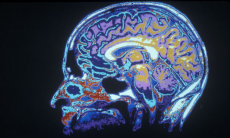
The biological approach is perhaps the most current stance to take within Psychology. It is based on the premise that since the mind resides within the brain, which in turn resides within the body itself, surely all behaviour and thought processes must be thought of as being biological. In this sense, only by studying the biology of the human nervous system can we understand the workings of the mind and human behaviour. The two main areas of interest within this field are firstly, the influence of genetics on an individual’s psychology and secondly, how the brain functions. The latter is generally known as neurobiology.
There are many different techniques used within neurobiology and they use a range of equipment, from microscopes to the much larger brain scanners. One such brain scanning technique is EEG (electroencephalography). This gives an overall reading on a chart of the brain waves leaving the head through the skull. It enables us to see how much neural activity is taking place, and in real time, but does not show exactly where within the brain the electrical activity is coming from.
A second well known technique is MRI (Magnetic Resonance Imaging), which enables a detailed picture of an individual’s brain. It uses a strong magnetic field, in order to create cross sectional images of the brain. With this, we can see what a person’s brain looks like in a large amount of detail, but it is restricted, since we can only see the constant physical properties, not what is going on inside the brain over a length of time.
In response to this issue, we can now use MRI scanners for fMRI, where the f stands for ‘functional’. This uses the known differences in the magnetic qualities of oxygenated and non-oxygenated blood to determine where in the brain oxygen is being taken, and so where activity is taking place. This means that we can determine areas of the brain that are responsible for different types of behaviour and processing. While the images from fMRI are slightly less detailed, we are able to see changes in the brain’s activity as they are taking place.
One last important technique to mention is TMS (Transcranial Magnetic Stimulation). This uses magnets to create or stop activity in a particular brain region for a short amount of time, without causing any harm. By doing this, we can learn which parts of the brain are used in which behaviours, since we can look for changes in behaviours just after they have undergone TMS. Of course, there are many other techniques adopted by neuroscientists completing brain research, but I have only been able to cover a few here.
There is some debate across the field of psychology as a whole, as to whether the study of the nervous system is in fact useful to understanding human cognition and behaviour, since research is currently limited mainly to outlining parts of the brain responsible for different types of behaviour and processing, and some would argue that neurobiologists simply locate sources of behaviour rather than actually contributing to further understanding of the behaviours themselves, and cannot help us to make rules about the behaviours that actually take place. It is hard to deny though that neurobiology does have worthwhile uses in some disciplines, such as the fields of medicine and psychiatry.
Image from: http://static.guim.co.uk/sys-images/Books/Pix/pictures/2013/6/11/1370953867775/Brain-Scan-MRI-011.jpg

0 Comment:
Be the first one to comment on this article.